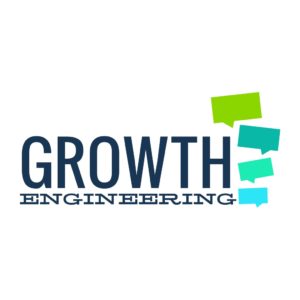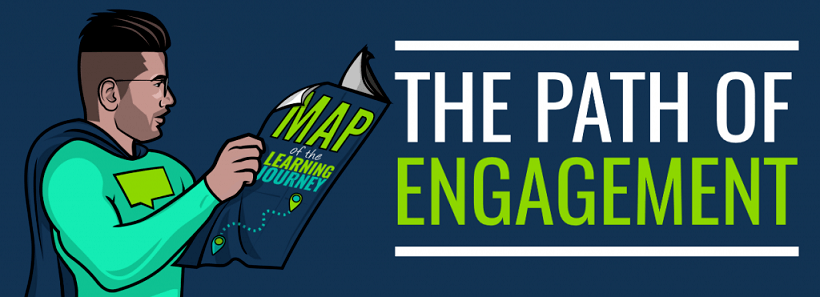Why Learner Engagement Is Crucial For Effective Learning
Normal, everyday people can’t become learning superheroes if they don’t enjoy their training and find it useful. This is why learner engagement is vital to the success of online learning projects.
Many learning managers are newcomers to the idea of learner engagement, but it’s been around for a long time – especially in the world of marketing. A marketer’s job is to engage strangers and turn them into customers. When it comes to grabbing your learners’ attention, you can learn a lot by looking at engagement from a marketer’s perspective.
Learner Engagement Is A Journey
Marketers think about engagement as a journey. At the start of this journey, the customer is completely unaware of the company or brand. As the marketer carefully shepherds them along the journey of engagement, and the customer’s relationship with the brand grows.
Learning managers should see the training program as a journey, not just a series of one-off sessions. Just like the world of marketing, this journey takes disinterested would-be learners and transforms them into active learners and brand advocates who take ownership of their own progress.
So, if engagement is a journey, what are the milestones along the way? Think of the path of engagement as a four-stage process including ‘the hook’, ‘the reaction’, ‘the conversion’, and ‘the result’.
These stages will help you see the journey through the eyes of a learner and understand what would engage them more effectively.
The Hook
At some point in your life, you’ve seen an advertisement that seems to speak directly to you as a person. When marketers want to entice a customer to engage with a brand for the first time, they need communicate everything that’s great about their product in a fraction of a second. This first impression is called the hook. For example, a television advert is a short, bite sized message which tells you why that product is perfect for you.
Compare that with the first five minutes of online learning most learners experience. Usually, the first impression they get is to expect long hours trying to stay awake. Learning shouldn’t be boring. You need to show the learners how great learning can be – not force them to wade through dull compliance training.
If you want your learners to be gripped from their very first login, don’t start slow and hope for the best – that’s not what a marketer would do. Instead, they would fire them up with a showcase of everything that gives the training significance for the learner. This Epic Meaning comes from the vision and values at the heart of the organisation, and it focuses on the reasons the employees go to work each day. If the learners know why they are taking the training, there’s a better chance that they’ll actually engage with it.
Everyone knows that first impressions matter. If you want to your learners to take the first steps along the path of engagement, you need to get them hooked!
The Response
Marketers don’t create one advert and then wish really hard – they need to keep the customer engaged. If they’re captivated for long enough they’ll have time to process the hook and respond to it, rather than just react to it. This response is the first glimpse of engagement.
The response is just as important with learning as it is with marketing. Once they’ve been hooked, does the learner carry on using the platform or do they log off, never to return? If the learning platform holds the learner’s interest for long enough then they’ll take initiative and navigate the site for themselves.
At the very least, the platform should be easy to use and bug-free, but you also need to put the fun back in functional! Using gamification in the learning platform gives people reasons to go the extra mile. They’ll work that little bit harder to earn more badges and get a little higher on the leaderboard.
This is the kind of response you need if you want your training programme to be truly effective. Engagement can only happen if the learning platform is intuitive, exciting and built with your learners in mind.
The Conversion
If a customer is happy enough with a company, they’ll be ready to move to the next step of the engagement path. ’Conversion’ describes the journey a person takes from being unaware of a company, to answering a ‘call to action’.
As a learning professional, can you say that you use calls to action in the same way? Maybe you just send an email telling the learners that they need to complete an assessment. People are more likely to take ownership of their learning if it speaks directly to them. Your call to action should be more like a battle cry, rousing your learners and getting them excited about learning new things.
If you want to measure conversion, you just need to keep track of autonomous logins- the times the learners log in because they choose to, not because they have to. Once learners are taking control of their own learning, you can safely say you’ve converted them and brought them closer to engagement.
The Result
A one-off purchase doesn’t make a thriving customer-company relationship. Today’s marketers want a life-long connection between customers and brands.
In the same way, a single autonomous login doesn’t make an engaged learner. The learning has to go beyond the formal content and take on a life of its own. Social learning tools let the learners share their own knowledge on the platform. Not only does this give them a greater sense of ownership, but it lets the company hold onto its intellectual capital. In this way, when employees move on to other companies, their knowledge needn’t go with them.
Ultimately, people are more likely to engage with a learning community of their peers than a faceless learning platform. When you’ve built this community, it marks the beginning of sustained engagement with online learning. It doesn’t stop at online learning either. Engaged employees work harder, try out new skills and aim to become even better!
The real result of a successful engagement strategy is a team of brand advocates who love their jobs and strive to help each other improve. When your training program is driving that kind of behavioral change, you can finally demonstrate a return on the investment.
Final Word
The path of learner engagement is simple, but it’s also significant. Small changes to the look-and-feel and the user experience speak to your learners. They will only buy into the idea of the training if it answers their needs and desires. Once you’ve done that, you’ll have a better chance of truly engaging them with their training.










